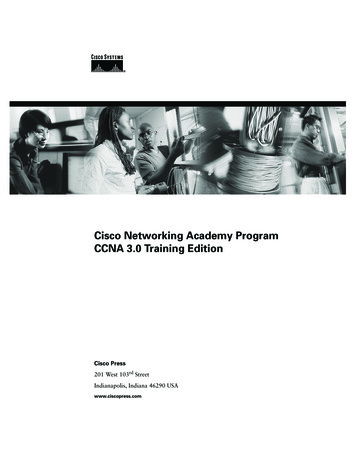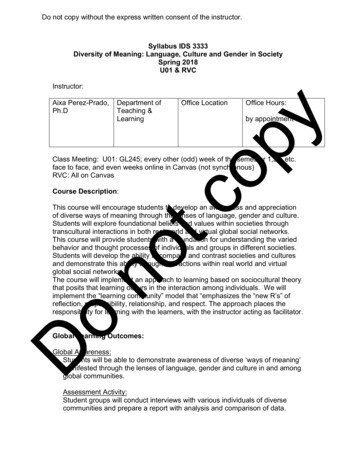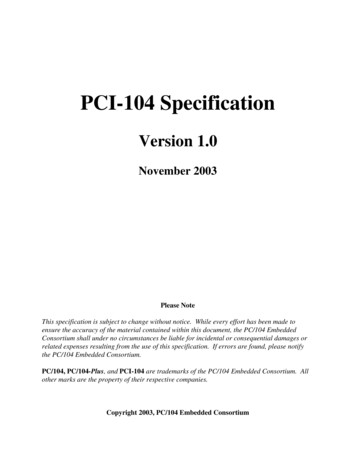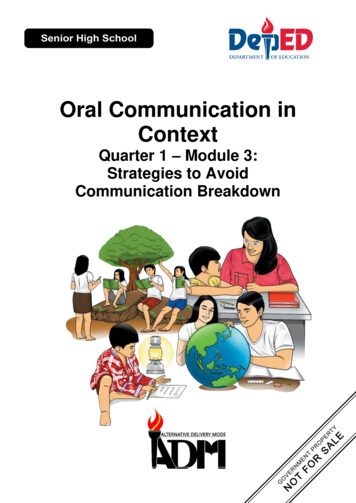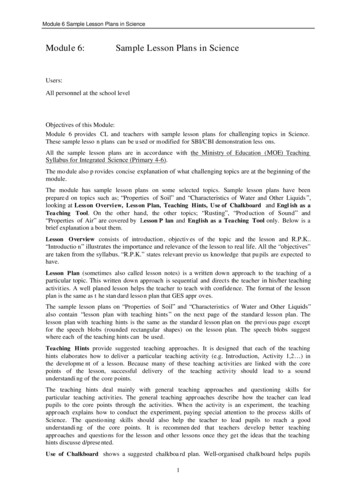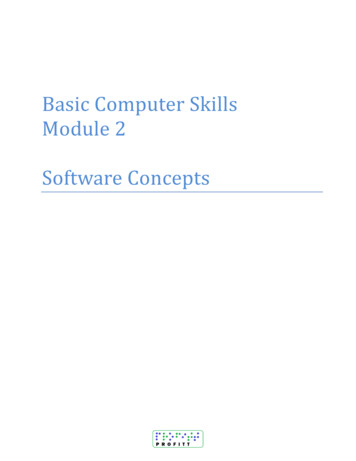
Transcription
Unit Nine: Teaching Students toComprehend Spoken English
Comprehension abilities precede productiveskills in language learning.The teaching of speaking should be delayeduntil comprehension skills are established.Skills acquired through listening transfer toother skills.Teaching should emphasize meaning ratherthan form.Teaching should minimize learner stress.
Acquisition-learning hypothesis (Acquisition is subconscious,whereas learning is consciously developed by instruction and aided byerror correction).Monitor hypothesis (Conscious learning is limited to use as a monitorthat can edit and make corrections in the learner's output before s/hewrites or speaks, but language fluency relies on acquisition).Natural order hypothesis (Learners acquire linguistic structures in apredictable order in L1 and a similar order is present in L2acquisition).Input hypothesis (Learners acquire language by exposure tocomprehensible input: "i 1". Learning is first focused on meaningand structure is learned as a consequence of understanding themessage).Affective filter hypothesis (Depending on the learner’s state of mind,the affective filter limits what is noticed and what is acquired. Thepresence of an affective filter could act as a mental block if a pooraffective state existed)
The Natural ApproachTotal Physical Response (TPR)
PrinciplesPedagogical Implications1. Comprehension precedes productions. That is,listening and reading skills will be acquiredbefore speaking and writing skills.a) Teachers speak in the target language only.b) Content is selected according to its relevanceto student interests.c) Teachers consistently provide comprehensibleinput.2. Language production emerges from nonverbalresponses, single words, combinations of twoor three words, to phrases, sentences, andultimately to complex discourse.3. The syllabus and course content is organizedaround topics with communicative goalsrather than linguistic structures.4. The learning environment must beconducive to language learning.a) The "silent period" is allowed; students arenever forced to speak before they arecomfortable doing so.b) Error correction is given only when errorsinterfere with communication.a) The teaching focus is on communicating ideaswith little or no attention to grammaticalaccuracy in the early comprehension andproduction stages.a) Activities should ensure that studentscan practice the language in a supportive,nonthreatening setting that reducesanxiety, promotes motivation, and buildsself-esteem.
Pre Listening-Purpose: introducelearners to the topic.-Purpose:IntroducevocabularyListening Exercises(play listening multipletimes)-Purpose: Listening fordetails-Type of Activities:-M/C activities-gap filling activities Vocabulary Activities-Purpose: Review use &comprehension of newvocabulary-Type of Activities:-M/C, T/F, gap filling,match, text completion,etc. (changes by level oflearner)Post Listening Activities-Purpose: Discussion,comprehension checks
nglishmedialab.com/listening.html
Is it really good for L2 learners to delaytheir oral production?Does the natural approach attend tolearner’s output? Can comprehensible inputalone lead to learners’ comprehensibleoutput?
Comprehensible InputLow-anxiety Learning Environment1. Computers allow teachers to addmultisensory elements, text, sound,pictures, video, and animation, whichprovide meaningful contexts tofacilitate comprehension.2. Computers allow learners to hear theavailable input as many times as neededuntil they feel they understand it.Example:- Adult Learning Activities - CaliforniaDistance Learning Project (news stories andInteractive exercises)1. Multimedia programs can be designedto present material at differentdifficulty levels with adjustments inspeed of delivery according toindividual learner needs.Example:- Randall's ESL Cyber Listening Lab2. Computers allow learners to developtheir autonomy to review and practicematerials as many times as they wish.3. Computers can provide immediate,nonjudgmental feedback andadditional assistance to learners. Theycorrect learners' errors without givingthem embarrassment or anxiety.
According to your language learningexperience with computers, do you thinkthose Computer Assisted LanguageLearning (CALL) programs always providecomprehensible input, particularly inlistening?Do you think the feedback from thecomputer is sufficient for language learnersto develop their listening skills ?
PrinciplesPedagogical implications1. Listening comprehension skills aredeveloped before oral production skills(based on the natural order of L1acquisition).1. Teachers speak in the target language tostudents and focus on students' listeningcomprehension in the early stage.2. Psychomotor association: Learning isenhanced through the association oflanguage with motor activity. Motoractivity is a function of the right-brain,and the right-brain activities shouldprecede the language processingfunctions of the left-brain.2. Teachers give command forms (i.e."Open the door") to which studentsrespond by physically doing the action.3. TPR lowers students' affective filter and 3. Teachers ask students to listen only butstress level.not to give an oral response.
Examples:- TPR Games (program description fromTPR World Website)- Review of Live Action Spanish Interactive(from Language Learning and Technology,Vol. 8, No. 3, September 2004, pp. 40-43)
TPR is usually used in the face-to-faceclassroom. Is there anything missing whenTPR is used on a computer?
“Listening is vital in the language classroom because itprovides input for the learner. Without understanding input atthe right level, any learning simply cannot begin. Listening isthus fundamental to speaking.”Rost, 1994
UnderstandInterpretevaluate One way exchangesIntrapersonalcommunication
determines a reason for listening;takes the raw speech and deposits an image of it in short-termmemory;attempts to organize the information by identifying the type ofspeech event (conversation, lecture, radio ad) and the functionof the message (persuade, inform, request);predicts information expected to be included in the message;recalls background information (schemata) to help interpret themessage;assigns a meaning to the message;checks that the message has been understood;determines the information to be held in long-term memory;deletes the original form of the message that had been receivedinto short-term memory
Top down processing Background knowledge &global understandingBottom up processing Uses language dataSoundsWordsGrammatical relationships
Global Previous knowledge on atopic Situational knowledgeBackground Schemata or plans aboutthe overall structure ofevents & the relationshipbetween them. Predicting a topic indiscourse & being able toinfer a sequence of events Real-world experiencesand the expectations wehave, about how peoplebehave.
Decoding soundsEg. /p/ is recognised as being /p/ and not /b/, /i:/ asbeing /i:/ and not /i/ or /e/ and so on Combining sounds into words and words aredecoded (i.e the listener recognizes that s/he hasheard /pi:t/ and not /pit/ /bit/ /bi:t/ /bi:d/ Words combined into sentences and listenerworks out meaning of /pi:t/ : as in I saw Peteyesterday or I bought some peat for the garden. Recognizing intonation
Imagine the following situations:Over lunch, your friend tells you a story about a recentholiday, which was a disaster. You listen with interestand interject at appropriate moments, maybe toexpress surprise or sympathy.That evening, another friend calls to invite you to aparty at her house the following Saturday. As you’venever been to her house before, she gives youdirections. You listen carefully and make notes.
Encourage them to use their knowledge ofthe topic to understand the content by‘guessing meaning’Use pictures, sequencing events, listening toconversations and identifying where theytake placeHave students read information about atopic and then listen to find whether or notthe same points are mentioned
The teacher reads out anumber of sentencesStudents write down howmany words there would bein the written form (ie.Writes the sentence)Learners compare answersbefore listening again I’m going to the shop.Do you want some chocolate?Let’s have a party!I’d better go soon.You shouldn’t have told him.What are you doing?There isn’t any coffee.What have you got?He doesn’t like it.It’s quite a long way.Why did you think you’d beable to?Can you tell him I called?
1.http://www.youtube.com/watch?v JYC6qRckNRE2.Which top down/bottomup processes helped youto understand thelanguage in this video?What aspects of thisconversation do you thinkan ESL learner wouldstruggle with?
Interactional purposesTransactional Purposes The focus is on harmoniouscommunication in socialcontexts.Interactional uses oflanguage typically includegreetings and small talk thatcenter on noncontroversialtopics that elicit agreementamong the participants.Interactional uses oflanguage do not requirecareful attention to detailsand facts. The focus is on conveyinginformation and language useis message oriented.Transactional uses of languageinclude listening to lectures,taking notes, and practicingdictations and cloze exercisesthat require understanding ofdetails.Transactional language isexplicit, clear, and coherent inorder for the listener tocomprehend the meaning of themessage.
In everyday language use, we often carryout both interactional and transactionalfunctions of language at the same time. Canyou always distinguish which languagefunction you are using? If it is difficult todistinguish them, then why do we have tolearn these two functions separately?Explain your answer.
Identifying Linguistic FeaturesResponding to Requests and CommandsInteracting as a ListenerComprehending Extended SpeechProblem Solving
Make learners aware of the linguisticfeatures of EnglishFocus on bottom-up processingLittle attention given to transactional orinteractional purposes
Sound blendsDidja have a good time?Whatcha doing?Where ya goin?Stress & Rhythm“He’s a great actor” Stress on nouns, mainverbs, adverbs, adjectivesonly“terrific” Words with more than onesyllable receive stress onONE syllable only in theword
Where would you mark stress in each ofthese?1.Would you sell my car because I’ve gone toFrance?2.Where did you go?3.Roses are red .4.Close the door!
Total Physical ResponseTeacher Command:Student Response:Teacher Command:Student Response:Teacher Command:Student Response:Sit down.(Students sit down)Open your books.(Students open books)Write your name.Students write theirname
Select action verbse.g. touch Combine a verb with a noune.g. nose touch; chin touchCommand:Touch your nose/Touch your chin
Chat Students view short videoclips of interactions indifferent social settings Aim of these activities isfor student to not onlycomprehend the listening,but to also work out whatis a safe topic to talk aboutand how to maintain theinteractionEavesdropping Focuses attention on thefunction of listening Aim is to teach studentsthe value of listening in ona conversation
Picture ordering activityStudents listen to a weather forecast and draw picturesrepresenting the weather for each day in the week.Cloze activitiesIn these activities students are given a worksheet with awritten extract of a listening passage. Each of the sentenceson the worksheet have words missing and students areexpected to complete the sentences with the word(s) theyhear in the listening. There are two ways to do this type ofactivity. Learners may either be given a choice of words tochoose from or not.
http://www.123listening.com
http://www.youtube.com/watch?v PdVIFiQy8v4&feature relatedhttp://www.last.fm/music/Eagles/ /Hotel California
Students expected to solve a problem basedupon what they hear in a listening passage
radio Songs Drama Advertisements Talk showstelevision Quiz showsSoap operasComediesReality showsCartoonsDocumentariesEducational programsNewsWeatherMoviesAward showsCommercials
Silent Viewing View videow/o sound toconsider whatis going on andwhat speakersaresaying/doingSoundtrack Only Listen tosoundtrackonly w/opicture andspeculate onwhat speakerslook like, thesetting, thelocationBeginning Only View thebeginning of asequence, thepredict whatwill happenEnding Only View theending andconsider whathappenedearlierSplit Viewing(One) Some stdtsview thematerial w/orsound. Otherslisten w/oviewing.Groups cometogether tocreate a fullerunderstandingof the context& contentSplit Viewing(Two) Half the classsits with backto screen. Halfcan see thescreen. Bothcan hear. Pairsthen build afullerunderstandingof context &content
For Teaching Listening
Keep listening passages shortPlay the tape a sufficient number of timesLet students discuss their answersDon’t immediately acknowledge correctanswers with words or facial expressions—throw the answers back to the class (“What doyou think of Bill’s answer—do you agree?)Don’t be led by one strong student. Have theyall got it?
Aim to get the students to agree together withoutyour help.Play little bits of the tape again and again until it’sclearGive help if they are completely stuck—but still withthe aim of getting them to work it out on their ownGive them control of the tape recorderDon’t cheat them by changing your requirementshalfway!Don’t let them lose heart. Try to make sure the taskis just within their abilities.
Lead-inPre-listening:intro to topic,discussion,looking atpictures, etc.Set Clear TaskPre-task work(optional)Eg. Lookingthroughworksheet, workon vocabulary,predicting, etc.Yes.ConcludeTie up looseends, lead tofollow-upactivities, reviewwhat has beenlearned, etcPlay tapeStudents should not betrying to understandeverything. They onlyneed enough to do aspecific assigned taskNo.Could they dothe task?Feedback on taskSt-st OR St-TDon’t ask unfair questions—you set a cleartask—have they done it? Don’t throw in a wholepile of extra questions now.
Pre-listening Stage:a)Introducing the topic and assessing their backgroundknowledge of the topicb)Activating their existing knowledge through discussion.Reading through comprehension questions in advance,working out own opinion on a topic, predicting contentfrom the title etc. can be done.c)Clarifying any necessary contextual information andvocabulary to comprehend the text. In this regardshowing pictures, maps or graphs and may be helpful.d)Inform students of listening expectations (i.e. what theyhave to do)
Listening to the Passage:a)Play the tape 1 time through and havestudents listen for the main ideab)Before playing the tape a second time, writesome basic comprehension questions on theboard for learners to focus on.c)Before playing the tape a 3rd time, drawlearners attention to the questions and reviewquestions with the studentsd)Play the tape and have learners listen andanswer the prepared questions
Post-listening Stage:a. Review vocabulary items found in thelisteningB. Comprehension check of specificinformationc. Review student answers to the questions
Develop a listening lesson plan for anintermediate level class. Include a listeningworksheet for students.
1.2.3.4.Gebhard, Jerry G. (2009). Teaching English as a Foreign/SecondLanguage. Ann Arbor, MI: The University of Michigan Press.Parrish, Betsy. (2004). Teaching Adult ESL. New York: McGrawHill.Rubin, J. and I. Thompson. (1994). How to Be a More SuccessfulLanguage Learner. Boston: Heinle & Heinle, 1994.Van Duzer. (1997). Improving ESL Learners’ Listening Skills: Atthe Workplace and Beyond. Journal of the Center for AdultEnglish Language ts/LISTENQA.html)
Comprehend Spoken English Listening was first recognized as a major component of language learning and teaching in the late 1970s. At that time, researc\൨ suggested that language instruction should focus on the learner's listening comprehension in the early stages of acquisition, 對whil




